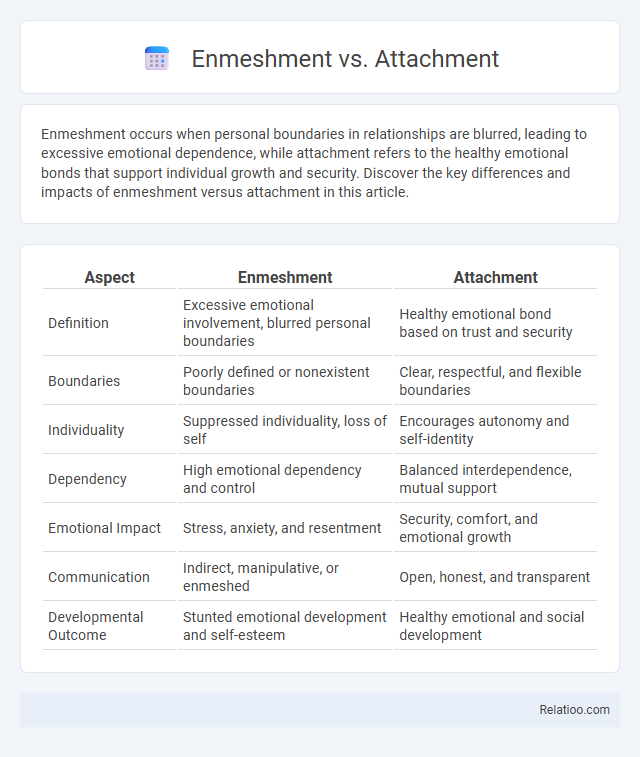Enmeshment occurs when personal boundaries in relationships are blurred, leading to excessive emotional dependence, while attachment refers to the healthy emotional bonds that support individual growth and security. Discover the key differences and impacts of enmeshment versus attachment in this article.
Table of Comparison
| Aspect | Enmeshment | Attachment |
|---|---|---|
| Definition | Excessive emotional involvement, blurred personal boundaries | Healthy emotional bond based on trust and security |
| Boundaries | Poorly defined or nonexistent boundaries | Clear, respectful, and flexible boundaries |
| Individuality | Suppressed individuality, loss of self | Encourages autonomy and self-identity |
| Dependency | High emotional dependency and control | Balanced interdependence, mutual support |
| Emotional Impact | Stress, anxiety, and resentment | Security, comfort, and emotional growth |
| Communication | Indirect, manipulative, or enmeshed | Open, honest, and transparent |
| Developmental Outcome | Stunted emotional development and self-esteem | Healthy emotional and social development |
Understanding Enmeshment: Definition and Key Characteristics
Enmeshment occurs when personal boundaries between individuals become blurred, leading to excessive emotional involvement and loss of individual autonomy. Unlike healthy attachment, which fosters secure connections and emotional support, enmeshment results in overdependence and difficulty distinguishing one's own feelings from others'. Your ability to recognize these key characteristics can help establish healthier relationships and promote emotional independence.
Defining Attachment: Types and Healthy Patterns
Attachment refers to the emotional bond formed between individuals, typically between a child and caregiver, which influences social and emotional development. Types of attachment include secure, anxious-ambivalent, avoidant, and disorganized, each reflecting varying degrees of trust and security in relationships. Healthy attachment patterns promote emotional regulation, resilience, and the ability to establish stable, supportive interpersonal connections.
Core Differences Between Enmeshment and Attachment
Enmeshment involves blurred boundaries and loss of individual autonomy, where personal identities are overly intertwined, leading to dependency and difficulty in self-regulation. Attachment refers to the emotional bond between individuals, characterized by security, trust, and healthy interdependence, supporting emotional development and resilience. The core difference lies in the quality and functionality of the relationship: enmeshment restricts personal growth through excessive closeness, while attachment fosters emotional security and independence within connection.
Psychological Effects of Enmeshment
Enmeshment in relationships leads to blurred boundaries and loss of individuality, causing psychological effects such as anxiety, low self-esteem, and impaired emotional regulation. Unlike secure attachment, which fosters healthy independence and connection, enmeshment creates codependency and identity confusion. Understanding these distinctions highlights the importance of establishing clear personal boundaries to promote psychological well-being.
Benefits of Secure Attachment in Relationships
Secure attachment fosters trust, emotional safety, and effective communication, which are essential for healthy relationships. Your ability to form secure attachments enhances empathy, resilience, and intimacy with partners, promoting long-term relationship satisfaction. Unlike enmeshment, which blurs personal boundaries, secure attachment maintains individuality while encouraging connection, supporting mutual growth and respect.
Signs of Enmeshed Family Dynamics
Signs of enmeshed family dynamics include blurred personal boundaries, over-involvement in each other's lives, and a lack of individual autonomy. Family members may struggle with defining their own identities due to excessive emotional dependence and intrusive behaviors. These dynamics often lead to difficulty in developing healthy attachments and establishing emotional independence.
Identifying Healthy Attachment Bonds
Healthy attachment bonds are characterized by secure emotional connections, trust, and mutual respect between individuals, allowing for independence and interdependence without losing personal boundaries. Enmeshment blurs these boundaries, leading to over-involvement and a loss of autonomy, whereas attachment involves balanced emotional closeness with clear differentiation of self. Identifying healthy attachment requires recognizing patterns of reliable support and emotional availability, distinct from enmeshed relationships marked by excessive dependence and boundary confusion.
How Enmeshment Impacts Emotional Development
Enmeshment disrupts healthy emotional development by blurring boundaries between individuals, causing an excessive emotional dependence on caregivers that hinders autonomy and self-identity formation. Unlike secure attachment, which fosters trust and independence, enmeshment leads to confusion in emotional regulation and difficulty managing personal emotions. This over-involvement impedes the ability to develop resilience and emotional maturity, often resulting in anxiety and relational difficulties in adulthood.
Healing from Enmeshment: Strategies and Support
Healing from enmeshment involves establishing clear personal boundaries and fostering emotional autonomy within relationships. Therapeutic approaches such as cognitive-behavioral therapy (CBT) and family systems therapy provide structured support for individuals to differentiate their identity from enmeshed dynamics. Support groups and mindfulness practices further enhance self-awareness and resilience, promoting healthier patterns of attachment and individuation.
Fostering Healthy Attachments: Tips and Best Practices
Fostering healthy attachments requires clear boundaries to prevent enmeshment, which blurs individual identity and hinders emotional growth. You can promote secure attachment by encouraging open communication, respecting personal space, and validating emotions without becoming overly involved or controlling. Consistent support paired with autonomy helps build trust and emotional resilience in relationships.

Infographic: Enmeshment vs Attachment
 relatioo.com
relatioo.com